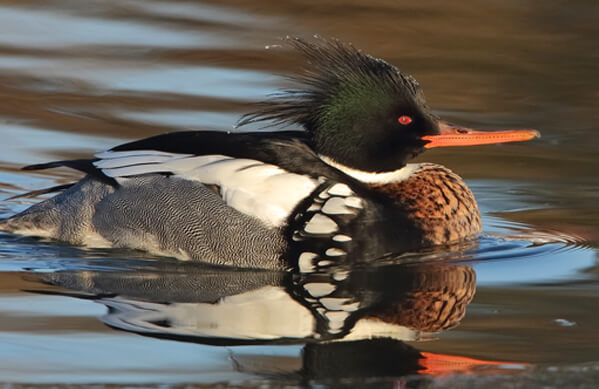
Red-breasted Merganser range map showing the North American distribution. Map by Birds of North America, https://birdsna.org, maintained by the Cornell Lab of Ornithology
The handsome Red-breasted Merganser is a welcome sight along coastlines during the winter. This sea-going duck is notable for its long, red, serrated bill, which gives it the species name serrator. Unlike the Wood Duck or American Black Duck, it is a diver — as referenced in its genus name Mergus, or diver — able to stay beneath the water's surface for almost a minute while foraging as deep as 15 to 20 feet.
Bed-headed Bird
One of the Red-breasted Merganser's notable features is a shaggy-looking double crest, which reminds some of a bad case of "bed head." The colorful male sports a metallic-green head, white neck band and wing patches, a red bill and eyes, and a reddish, black-speckled breast, for which the bird is named. The female is mostly gray with an orange-brown head.
North to South
The Red-breasted Merganser frequents salt water more than the other two North American mergansers, the Common and the Hooded. It breeds in northern regions around the globe, from Europe to Asia to North America, where it nests from Alaska, across northern Canada, down to the Great Lakes, then east to the Maritimes on the Atlantic coast.
In North America, this duck is a medium- to short-distance migrant, moving south in small flocks to winter on the Great Lakes and along both coasts as far south as northern Mexico and the Florida Keys.
Expert Diver, Flexible Forager
Red-breasted Mergansers dive underwater in search of a wide variety of fish and fish eggs, occasionally capturing worms, shrimp, and crabs as well. They are able to deftly navigate both above and below the water's surface. While they seem to prefer foraging in shallower water, Red-breasted Mergansers will hunt wherever prey is abundant, using a variety of feeding strategies, including floating at the surface, looking underwater as they go; diving in search of prey; and diving in formation to herd schooling fish such as herring.
Like other diving ducks, loons, and grebes, Red-breasted Mergansers are awkward on land because their legs are located far back on their bodies.
Head Shakes and Curtsies
Red-breasted Mergansers form mated pairs each season during their spring migration, usually starting in March. Groups of males gather to display for a single female, but unlike the Buff-breasted Sandpiper and Greater Sage-Grouse, these roving groups of male mergansers are not considered leks, as they don't congregate in a specific location.
Male Red-breasted Merganser displays include "head shake" or "salute curtsy" movements. In the latter, the male drops his bill forward, then flicks it up while rising chest-high in the water before dropping back, accompanied by a backwards kick. Although generally silent, the male Red-breasted Merganser emits a distinctive cat-like yeow-yeow during this display.
The Red-breasted Merganser also has a unique flight call:
(Audio of Red-breasted Merganser flight call by Peter Boesman, XC322851. Accessible at www.xeno-canto.org/322851)
Unlike other mergansers, which usually nest in tree cavities, Red-breasted Mergansers nest on the ground in a variety of sites near water, including marshes, rocky islets, islands in large lakes, and under piles of driftwood. Once mated, the female merganser (or hen) nests and raises her brood alone.
Merganser Day Care
Hen mergansers often lay eggs in the nests of other mergansers and sometimes those of other duck species as well. Broods in North America average five to 24 eggs, but as many as 56 eggs have been observed in a nest, thanks to contributions from several females! This parasitic behavior may benefit the species by increasing overall duckling production, as it lessens the risk of predation through sheer numbers. And by laying eggs in different nests, females reduce the chances of losing all of their reproductive effort if their own nest is destroyed. In other words, they don't put all their eggs in one basket.
Red-breasted Mergansers exhibit high nest-site fidelity, and several closely related females may nest near each other. In these cases, the “genetic” costs of brood parasitism would be reduced, as the hosts would be rearing the young of closely related individuals. After hatching, broods often combine into “nurseries” or “crèches,” with one female caring for a large group, while other hens take the opportunity to feed and rest away from their broods.
Saving a Sawbill
Declines in North American Red-breasted Merganser populations have been noted, likely due to a variety of reasons. Some populations may be threatened by wetland destruction, and climate change can make nests near water increasingly vulnerable to flooding.
Red-breasted Mergansers and other diving ducks are frequently caught and drowned in fishing nets and may suffer when wetlands and lakes are contaminated by pesticides. Like other fish-eating birds such as Double-crested Cormorants, Red-breasted Mergansers may be persecuted by owners of fish farms and by fishers, who claim that they deplete fish stocks.
Poorly sited Wind Energy
Poorly sited wind energy facilities also pose a threat. ABC has joined forces with Black Swamp Bird Observatory to oppose the Icebreaker Wind project, a wind energy facility proposed for Lake Erie, offshore of Cleveland, Ohio. This project would be sited in an Important Bird Area used by a globally significant population of wintering Red-breasted Mergansers. Lake Erie is also an important migratory route for species such as the Kirtland's Warbler.
Renewable energy such as wind energy is vital in the fight against climate change. However, proper siting is essential to minimize impacts on birds and other wildlife. ABC and partners believe this migratory corridor is a high-risk, inappropriate location for wind energy development, which would present serious risks to the millions of birds and bats that migrate through the area each year and use the biologically fertile waters of Lake Erie as feeding and breeding grounds.
Donate to support ABC's conservation mission!




















































